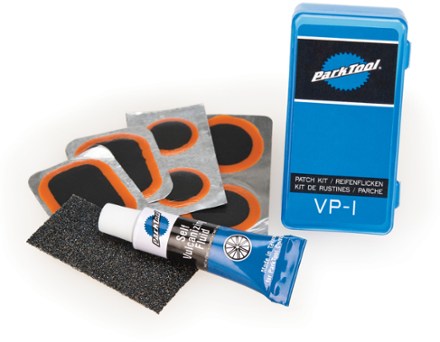The stock tire on a new Turbo Como 4.0 IGH is a Pathfinder Sport Reflect, 650Bx2.3 (front and rear). If I were to experience a flat tire while out riding, far from any local bike shop, what should I have with me in my trunk bag to at least help me get back home (let's say 20 miles away)? I understand that there is a range of variables here, front or rear tire, thorn or nail, and others, but I don't want to be caught without anything, so, what do you suggest I bring along? Thanks, in advance, for your thoughts, suggestions and/or experiences.
You are using an out of date browser. It may not display this or other websites correctly.
You should upgrade or use an alternative browser.
You should upgrade or use an alternative browser.
Turbo Como 4.0 IGH: How to be prepared for flat tire?
- Thread starter jmillr
- Start date
fooferdoggie
Well-Known Member
this can really help I did not have any flats that stopped me I 3000 miles. plus the tires stopped leaking air but it took about 3000 miles to do it.

 shop.flatouttire.com
shop.flatouttire.com

SINGLE QUICKSTRIKE SMALL TIRE 16OZ
OUR FASTEST SEALING FORMULAS YET: **NEW & IMPROVED** : FlatOut QuickStrike Small Tire/Bicycle Formula flows to the puncture quicker for when there’s no air to spare….and it is easier to install! DOUBLE THE PERFORMANCE AS THE COMPETITION: FlatOut QuickStrike Tire Sealant is a one-time application...
 shop.flatouttire.com
shop.flatouttire.com
Yes, the IGH has a belt drive. So removing the rear axle allows you to remove the rear wheel from the frame?My wife and I have Vados. I put some Allen wrenches in a bag that I carry on the bike so I can remove the rear axle. The Como 4.0 is a belt drive, correct?
I’m not sure how to use this product; do you spray it onto the leak? How do you know where to spray it?this can really help I did not have any flats that stopped me I 3000 miles. plus the tires stopped leaking air but it took about 3000 miles to do it.

SINGLE QUICKSTRIKE SMALL TIRE 16OZ
OUR FASTEST SEALING FORMULAS YET: **NEW & IMPROVED** : FlatOut QuickStrike Small Tire/Bicycle Formula flows to the puncture quicker for when there’s no air to spare….and it is easier to install! DOUBLE THE PERFORMANCE AS THE COMPETITION: FlatOut QuickStrike Tire Sealant is a one-time application...shop.flatouttire.com
fooferdoggie
Well-Known Member
no you put it into the tube and hopefully it will plug the hole without you having to do anything.I’m not sure how to use this product; do you spray it onto the leak? How do you know where to spray it?
Is this like a standard bit of gear everyone carries with them?no you put it into the tube and hopefully it will plug the hole without you having to do anything.
Okay, after reading a few other threads I see that one inserts the FlatOut into the tubes before riding and it is supposed to plug a puncture from the inside (once the nail or glass shard or whatever has been removed). So the gear you bring is a pair of pliers to do that removal and some kind of pump to restore lost air pressure.Is this like a standard bit of gear everyone carries with them?
Is this standard operating procedure? Or is it just for people who ride on riskier terrain?
kahn
Well-Known Member
- Region
- USA
- City
- northWET washington
Is that easy to accomplish in the field? Through the narrow presta valve? And then inflate the tube/tire?no you put it into the tube and hopefully it will plug the hole without you having to do anything.
On our Vados, once you remove the rear axle, you can remove the rear wheel. I’m not sure about your belt drive bike, but I would think it’s the same.Yes, the IGH has a belt drive. So removing the rear axle allows you to remove the rear wheel from the frame?
Practice it a couple times at home, before you have a flat in the middle of nowhere.
Use caution with the stuff you put into the tubes. It will work for small holes but if you slice the tube or tear off the presta valve, it won’t work. You’ll need to replace the tube and the only way to do that is by removing the rear axle. You should carry a spare tube, patch kit and inflator with you on your rides.
fooferdoggie
Well-Known Member
I do it it may or may not help. but it's cheap and if t save you fixing flat its worse it.Okay, after reading a few other threads I see that one inserts the FlatOut into the tubes before riding and it is supposed to plug a puncture from the inside (once the nail or glass shard or whatever has been removed). So the gear you bring is a pair of pliers to do that removal and some kind of pump to restore lost air pressure.
Is this standard operating procedure? Or is it just for people who ride on riskier terrain?
Yes we use it in our Levos.I do it it may or may not help. but it's cheap and if t save you fixing flat its worse it.
Ideally you should be prepared to remove either wheel and replace or repair the tube. Sealants dry out. Or you get too big a puncture. Cell service isn't always available to call a Lyft ride home to get your car/truck with a bike carrier.
Your Vado user manual shows how to remove and reinstall the rear wheel on IGH bikes.
If that's unclear, your LBS should be able to show you - around here many LBS do free monthly "basic maintenance"seminars including addressing flats.
And honestly, if you have a spare tube + appropriate tools + CO2 cartridges / pump and sit there looking bewildered, there's a good chance another cyclist will offer to help.
Your Vado user manual shows how to remove and reinstall the rear wheel on IGH bikes.
If that's unclear, your LBS should be able to show you - around here many LBS do free monthly "basic maintenance"seminars including addressing flats.
And honestly, if you have a spare tube + appropriate tools + CO2 cartridges / pump and sit there looking bewildered, there's a good chance another cyclist will offer to help.
Saratoga Dave
Well-Known Member
I sense that you’re looking for some basic knowledge here to make yourself more comfortable. You can’t go wrong with Park Tool How To videos, though there are many, many others:
Basic repair patch kit, two tire levers, a spare tube (look up the Gaadi style tubes that can be installed without removing the rear wheel), a Leatherman or similar that has a knife blade and pliers to pull things out of the tire, are the absolute basics. Dollar bill or Clif bar wrapper or similar to use as a tire boot (find a YoutTube video on this) as well, for larger sidewall slashes and other fun things.
Of course, we all know that these things only happen when it is 90 degrees plus or raining like hell, but that’s cycling.
And gburdell is absolutely correct in his last sentence above, if you stand alongside the bike path looking dazzled enough, people will surely stop and help you. Not the roadies, of course, but everybody else
Basic repair patch kit, two tire levers, a spare tube (look up the Gaadi style tubes that can be installed without removing the rear wheel), a Leatherman or similar that has a knife blade and pliers to pull things out of the tire, are the absolute basics. Dollar bill or Clif bar wrapper or similar to use as a tire boot (find a YoutTube video on this) as well, for larger sidewall slashes and other fun things.
Of course, we all know that these things only happen when it is 90 degrees plus or raining like hell, but that’s cycling.
And gburdell is absolutely correct in his last sentence above, if you stand alongside the bike path looking dazzled enough, people will surely stop and help you. Not the roadies, of course, but everybody else
fooferdoggie
Well-Known Member
its also a good idea to try it out while at home. so you know the basics. my first flat on my e bike after years of not riding was fun for a bit.
m@Robertson
Well-Known Member
- Region
- USA
You can skip some of the stuff in here as I expect its a bit beyond your comfort level at the moment, and of course the hockey pucks aren't applicable. But this article also explains each item, and why for example small needlenose pliers should be in your tool bag.
You should add tire sealant before you go on your ride as a necessary preventative.

 talesontwowheels.com
talesontwowheels.com
You should add tire sealant before you go on your ride as a necessary preventative.

(e)Bike Tool Kit – The 2022 Edition
In the last few months, I’ve made a few changes to my standard on-bike tool kits. Lets take a look.
 talesontwowheels.com
talesontwowheels.com
its also a good idea to try it out while at home. so you know the basics. my first flat on my e bike after years of not riding was fun for a bit.
100% this. The best place to test your tools and know-how is in the comfort of your own driveway or garage or patio. Especially if you're new to using CO2 cartridges or a portable pump. Much easier to figure things out and learn the process when you're not sitting beside the road or pathway worried how you're getting home.
m@Robertson
Well-Known Member
- Region
- USA
Standard operating procedure if you are smart. I can't count the number of times I have had to pull out a nail and spin the tire for the FlatOut inside to seal my tire. Or a glass shard or a bit of twisted metal. You use small needlenoses because they grip glass painlessly versus fingertipsIs this standard operating procedure? Or is it just for people who ride on riskier terrain?
Also, insofar as tools go, I work on my bikes and don't take them to the local bike shop. I try and work with the tools I keep in the bike pouch always. That way on the side of the road I am not cussing out the limited bits I am working with; they are what I normally use. Obviously the specialty stuff is at home but you don't need much for roadside-type work.
Te. S
Active Member
- Region
- USA
for most flats you should have a flat repair kit ( a patch kit and some Co2 canisters ) most of times you do not need to remove the wheel just need to get the tube out and use a patch to fix the flat and get it back inside the Tire this what i carry with me. i like the idea of the Flat Out

 www.rei.com
www.rei.com
 www.jensonusa.com
www.jensonusa.com
 www.jensonusa.com
www.jensonusa.com

Park Tool VP-1C Tire Patch Kit | REI Co-op
The Park Tool VP-1 tire patch kit includes 6 thin and flexible patches with tapered edges that blend with the tube's profile for a permanent, reliable fix.
Lezyne Repair Kit | Jenson USA
Lezyne Repair Kit | Jenson USA
Similar threads
- Replies
- 22
- Views
- 3K
- Replies
- 7
- Views
- 2K
- Replies
- 25
- Views
- 2K
- Replies
- 38
- Views
- 5K